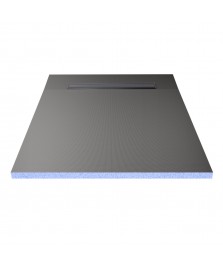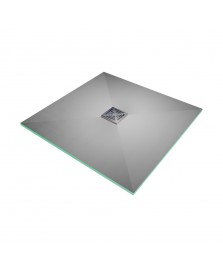- today
- label Wet Room Kits
- favorite 0 likes
- remove_red_eye 1792 views

When it comes to creating the perfect bathroom, choosing the right shower tray is crucial. Whether you're installing a walk-in shower or planning a complete wetroom, understanding the difference between a 2-way shower tray and 1-way shower tray can help you make an informed decision.
In this comprehensive guide, we explore everything you need to know about these two types of shower trays. We discuss their features, advantages, and uses to help you choose the right one for your space.
What Are Shower Trays?
Shower trays are the foundation of your shower area, providing a stable and waterproof base for your shower enclosure. Their primary function is to collect water and direct it towards the waste outlet.
They come in different types, shapes, and sizes, each designed to suit specific bathroom layouts and requirements. Understanding the various types of shower trays is the first step towards choosing the right one for your bathroom.
What Are 1-Way and 2-Way Shower Trays?
Shower trays can be categorised according to their drainage design and the direction of water flow. The two primary types are 1-way and 2-way shower trays.
1-Way Shower Trays
A 1-way shower tray has a slope on only one side. It’s also referred to as a single-slope or single-fall shower tray. It directs water towards a drain located on the lower edge.
2-Way Shower Trays
A two-way shower tray is designed with slopes on two opposite sides. It’s also known as a dual-slope or two-fall shower tray. The slopes direct water towards a linear drain between them.
Key Differences Between 2-Way and 1-Way Shower Trays
Let’s take a closer look at how these two shower tray designs differ:
1. Slope Design and Drainage
The most fundamental difference lies in the slope design. A one-way tray slopes gently towards a single edge where the drain is located. This traditional design is simple and effective for many shower enclosures.
On the other hand, a two-way tray boasts dual slopes that converge towards a central linear drain. This innovative design ensures faster and more efficient water drainage, making it ideal for wetrooms or larger showers prone to water pooling.
2. Installation and Suitability
If you're considering a DIY project, a one-way tray is typically easier to install as it requires less precision in levelling. It's also a practical choice for smaller bathrooms or shower enclosures, as they are typically available in smaller sizes.
However, if you have a larger bathroom or are designing a wetroom, a two-way tray with a linear drain is often a better choice. While installation might be slightly more complex, the superior drainage outweighs the added effort.
3. Cost and Aesthetics
Budget is always a consideration and one-way trays generally come with a more affordable price tag (compared to two-way trays of the same size) due to their slightly simpler design. They offer a classic, understated look that suits various bathroom styles.
Two-way trays can be more expensive than their one-way counterparts. However, their contemporary design with minimalist linear drains adds a touch of luxury and sophistication to your bathroom. If you're aiming for a modern, spa-like feel, and a more efficient drainage system, the slight increase in cost may be well worth it.
1-Way and 2-Way? Choosing the Right Shower Tray
Choosing between a one-way and two-way shower tray ultimately depends on your individual needs and preferences. Consider the following factors:
-
Bathroom size: Opt for a one-way tray if you have a smaller bathroom or shower enclosure. Choose a two-way tray if you have ample space or a wetroom.
-
Budget: If you're working with a tight budget, a one-way tray might be the more economical choice.
-
Drainage needs: If efficient drainage is a priority, especially in a wetroom, a two-way tray with its dual slopes is a superior option.
-
Aesthetic preference: Choose a one-way tray for a classic look or a two-way tray for a contemporary, minimalist and more practical design.
Additional Considerations: A Shower Tray Buying Guide
Here are some additional factors to consider when selecting the perfect tray for your bathroom:
-
Material: Shower trays are made from various materials. Popular options are stone resin and acrylic shower trays.
-
Anti-slip surface: For added safety, consider choosing an anti-slip shower tray to prevent slips and falls.
-
Size: Standard shower tray sizes range from around 900 x 900mm to 1800 x 800mm for a more spacious shower.
-
Shape: Shower trays come in various shapes to suit different bathroom layouts. Common options are:
-
Square shower trays
-
Rectangular shower tray
-
Quadrant shower trays
-
Offset quadrant shower trays
-
Shower screen compatibility: Ensure your chosen tray is compatible with your desired shower screen or enclosure.
-
Height and accessibility: Low-profile shower trays are popular for their sleek appearance and improved accessibility. You can use a shower tray riser kit if you need to raise the tray.
Wetroomstop: Quality Shower Trays & Expert Bathroom Advice
Choosing between a 1-way and 2-way shower tray ultimately depends on your bathroom's layout, size, and desired design. Understanding the key differences between these two options allows you to make an informed decision that best suits your needs.
At Wetroomstop, we offer a wide range of level-access shower trays to suit various needs and preferences. We guarantee you’ll find the perfect fit for your wetroom or walk-in shower. Options include 1-way and 2-way shower trays and square or rectangular shapes. They're suitable for tiled, vinyl, or microcement floors. We also provide complete wetroom kits for your convenience.
Whether installing a new shower or renovating an existing one, we can help you choose the right shower tray and other components to create your dream wetroom. Contact our expert team today. We’re available to answer any questions and guide you through the entire process.















